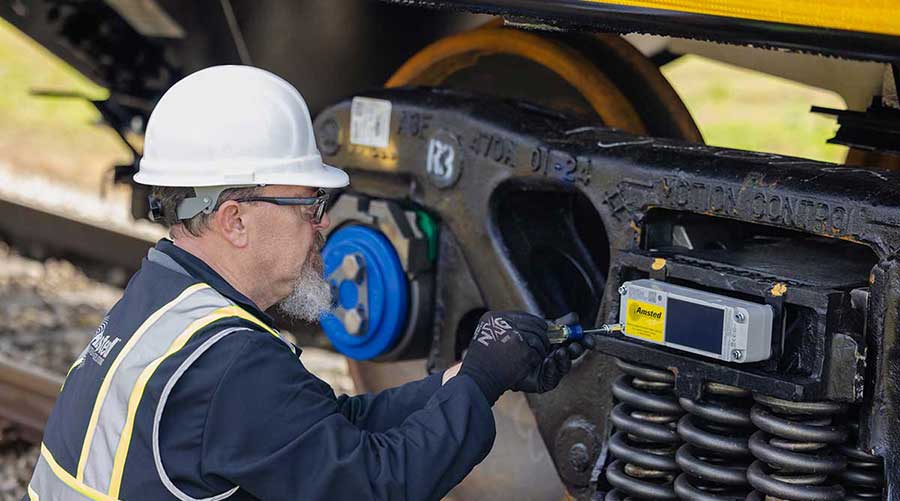Stay updated on news, articles and information for the rail industry
September 2013
Rail News: Rail Industry Trends
Crude-by-rail trend prompts railroads, engineering firms to streamline projects
By Angela Cotey, Associate Editor
The shale drilling boom of the past couple years has created a traffic and revenue boon for many North American railroads, as crude oil shipments have spiked and natural gas production has increased. While railroad officials will gladly take the traffic boost, the rapid growth is pressuring them to more quickly increase capacity — and that urgency is trickling down to rail engineering firms, contractors and industry suppliers.
So says Marc Cañas, vice president and chief operating officer of engineering and design firm JL Patterson & Associates Inc. Engineers are being asked to "work magic" to help railroads expedite infrastructure projects in six to eight months that typically would take 24 months to complete, he says.
Not that Cañas is complaining. Rail engineering firms are benefitting from the crude-by-rail traffic uptick, which he believes will continue over the long term. Railroads now are trying to position themselves to handle it.
"You can't talk about crude by rail as only crude traffic — you have to look at the impact the additional traffic is putting on the entire network," says Cañas.
With major shales in Pennsylvania, North Dakota, California, Texas and points in between, and crude shipments being made to refineries on the East, West and Gulf coasts, the majority of the U.S. rail network is impacted by crude traffic.
"When you start infusing this extra unit-train traffic on a network that in some areas is already constrained … it puts enormous pressure on railroads to increase capacity," says Cañas. "And now, they are caught in this unique situation where they used to be able to plan 30 years ahead; now, they are planning for what has to be done next year."
Many railroads are seeking to extend sidings, particularly in areas with single track or limited double track, or improve sidings to bring them up to mainline standards, says Cañas. Some also are looking at reviving old routes that now are seldom or never used.
When it comes to designing and engineering such projects, firms are under equal pressure to deliver projects quicker. JL Patterson, for one, is working to shorten the design timeframe by leveraging technology and streamlining processes.
For example, engineers are relying more heavily on public mapping data to begin the design process. Typically, firms send a surveyor and geotechnical expert to a site to develop maps and surveys, which takes about 30 days to complete. JL Patterson still will send workers to the field to collect the information they need, but in the meantime, engineers will start design work using the existing mapping data that's available, then tweak it as needed once the official survey is complete.
"There is an inherent risk of using this public mapping data because it's not controlled in the way that it is when we do a conventional survey, but we can use that data as part of our toolbox," says Cañas. "We won't use those maps in lieu of more finite field survey data, but we can use it to start design on day one. And that right there cuts 30 days out of a 24-month process."
Railroad officials also are conducting more "over-the-shoulder reviews" with engineering firms, says Cañas. In the past, firms would design a project to a certain point, submit it to the railroad for review, then wait for it to be returned with comments. Now, railroad project engineers hold virtual meetings with designers and are given access to the designers' computer screen via interactive technology that enables all participating parties to mark changes on the screen.
"It's really collaborative, and these intermediate design decisions are now made on the fly," Cañas says.
Firms are leveraging their own technology to speed design processes, as well. Most design software offers capabilities far beyond what engineers actually use it for, says Cañas. By learning more about those capabilities and determining how they can be rolled into the design process, engineers can shave time off a project.
Engineering firms and other rail industry players will need to continue efforts to help railroads streamline projects. Unlike the ethanol explosion from several years ago, crude oil — and transportation of the product by rail — is here to say, Cañas believes.
"This is only going to grow. Independent gas and oil refiners all seem to believe that the U.S. will become energy independent in the next 10 years," he says. "This is the real deal."


 LRW Honors Amtrak’s Acheson As Railway Woman Of The Year
LRW Honors Amtrak’s Acheson As Railway Woman Of The Year
 From Editor-In-Chief Foran: Of Gender Equity And Inclusion
From Editor-In-Chief Foran: Of Gender Equity And Inclusion
 Spotlight On Some Of Today’s Rail Safety Products
Spotlight On Some Of Today’s Rail Safety Products
 Women of Influence in Rail eBook
Women of Influence in Rail eBook
 railPrime
railPrime







